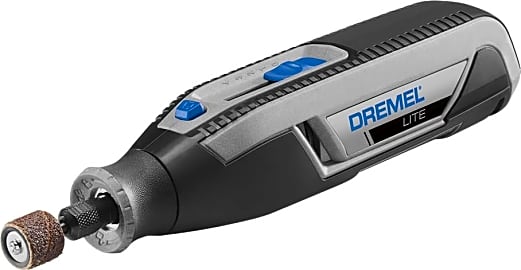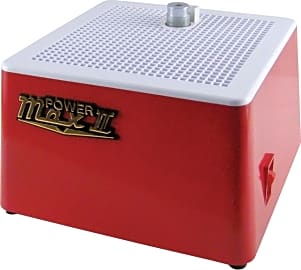The 10 Best Glass Grinders

This wiki has been updated 38 times since it was first published in December of 2016. Working with the beautiful, but fragile, medium of glass can present the artist or craftsman with a formidable challenge. The right equipment, however, can enable you to work with confidence, creating high-quality objects that are both functional and attractive. We have put together a list of the industry's best grinders, ranked here by their ease of use, versatility, and durability. When users buy our independently chosen editorial selections, we may earn commissions to help fund the Wiki.
Editor's Notes
February 17, 2021:
Favored by glass artists and hobbyists, these grinders are designed to shape, polish, and bevel the edges of cut glass. As with most power tools, especially ones which create fine particles, correct eye, respiratory, and hand protection is essential, and while many of these grinders come with face shields, such as Gryphon Convertible and the Glastar All Star G8, they won't protect you from the dust, which is an irritant.
When selecting a suitable glass grinder, the size of the workpiece is an important consideration. Most of the selections in this ranking, such as the Diamond Tech Power Max 2 and the Vicky Payne Super Star II, feature a flatbed design that provides a sturdy top on which small to medium-sized cuts can be worked on safely. However, for complex shapes, intricate detailing, or engraving work, a handheld option will provide greater control and accuracy. The Proxxon Complete Engraving Kit is a rotary tool that comes with several differently shaped diamond bits for beveling, smoothing, and engraving, whereas, the popular Dremel Lite 7760 is a versatile option that has a whole range of applications, and with the correct attachment is more than capable of intricate detail work.
For larger pieces, consistency is important. The newly added VGCE Wet Belt Sander features an adjustable platform that can be locked in place at a specific angle, making it easy to cut uniform bevels over multiple edges. This model uses fine-grit sanding belts as opposed to a diamond tip and needs plenty of water to keep things cool, meaning it can create a lot of spray, and therefore is not ideal for indoor use.
September 02, 2019:
Taking a closer look at this ranking, we wanted to make sure that glass artists and industrialists were being shown the best tools for the category, which is the primary reason we ultimately decided to do away with the Sickle Stone file previously at number four. Is it a great file? Sure. Does it belong on a list devoted to grinders? Probably not. Even the highly lauded wet belt sander by Covington was considered for removal, as an argument could be made that its very name belies a sanding purpose over a grinding one. In that case, we considered the fact that users can achieve similar grinding effects with it as they could some of the more compact grinders on our list, and that it ultimately came down to a given user's skill and needs. The very low ceiling offered by the Sickle Stone didn't allow for this level of consideration.
Interestingly, we only ended up with a single flat lap grinder on our primary list, but it is one of the most highly regarded in the Hi-Tech Diamond eight-inch. We found another flat option from Ameritool that made its way onto our special honors list for good measure, and that one comes with an excellent accessory kit, including a quartet of sanding discs (as well as a white polish pad) and an additional four backing plates.
Special Honors
D&L Art Supply TNG TG In addition to being one of the best-looking options on the market, this model offers an accessory tray with cutouts for easy organization and a larger eye shield than you'll find on much of the competition. Its top speed is also an impressive 4,500 RPM, and it's made in the United States. dlartglass.com
Ameritool Universal Heavy Duty If you're looking for a particularly strong flattop machine, this may be your best bet. It boasts a 1/4-horsepower direct drive motor, and comes with five ready-to-use discs as well as four backing plates for creating custom grinding surfaces. It's a bit on the heavy side, however, so it isn't the most portable choice, and it's quite expensive. kilnfrog.com
Grinding It Out: A Brief History Of Glass Making
Artisans simply added metallic salts during the manufacturing process to produce the desired results.
Before we knew how to make glass on our own, Stone Age humans made efficacious use of materials like obsidian, a naturally occurring volcanic glass. Still in use today, these handy little fragments are hard, yet brittle, so they can be easily fractured and manipulated into effective cutting tools and weapons, and when polished they make an excellent mirror or decoration. This inherent versatility made the material extremely valuable to ancient people, and because of this it was extensively traded.
Although no one knows for sure, archeologists have found evidence that the first manmade glass may have occurred in Egypt and Mesopotamia around 3500 B.C.E. Most likely, this ancient glass was a happy accident, possibly the by-product of a separate metallurgical procedure. Some experts suspect the process evolved from the creation of faience, a pre-glass material with a vitreous coating that occasionally consisted of powdered quartz melted at extremely high temperatures.
In an attempt to recreate the treasured gemstones of the day, ancient Romans and Egyptians produced colored glass. Artisans simply added metallic salts during the manufacturing process to produce the desired results. As the procedure evolved, this type of glass flourished alongside the spread of Christianity throughout Europe in the 4th and 5th centuries, popping up in the windows of cathedrals and churches. Creating a stained glass window took enormous skill, not to mention a hefty dose of engineering know-how in order to form the intricate designs. A worker needed to sand and file a piece ever so precisely so that it would fit within a complicated framework. Considering the monumental size of some of these projects, creating a complex biblical scene or other elaborate work of art was no mean feat.
Which Glass Grinder Is Right For You?
Whether you’re a DIY enthusiast making a wind chime for your home or a professional glass artist, you’ll need the proper tools to complete the task at hand. If you simply want to personalize an already formed item, such as a mug, plate, or bowl, then an engraving kit is a must. These kits provide the fine writing tools you’ll require to etch glass with delicate details and designs, like a name or a picture.
Not only do these devices provide an ample surface on which to work, but many models have ingenious methods to keep your glass wet.
For small jobs that require a light smoothing, like rounding out the edges of a microscope slide, sometimes nothing more than a sheet of wet and dry sandpaper or a handy nail file with the right grit can do the trick — so long as you don’t mind dousing the latter in water. Better still, a sickle stone file is an excellent choice for rough edges and sharp corners, especially if you frequently have to address small imperfections. For the hobbyist who requires a deft sanding for, say, turning reclaimed wine bottles into safe drinking glasses, a rotary tool will make quick work of the task. It's always a great idea to have one of these versatile devices around, as they can clean, polish, and sand a variety of materials.
If you need to address a broad surface area, a wet belt sander is the way to go. Especially ideal for those who work with large panes, these machines offer superb accuracy. They stay moist via hidden water reservoirs with standard sponges inside, and they often have tilting platforms that make beveling edges a breeze. You can easily change the belt to accommodate any job. For example, an extra coarse belt will swiftly eliminate a jagged edge, and a super fine one can leave a piece perfectly polished with a satin finish.
If you’re serious about your craft and want to take your projects to the next level, then it’s worthwhile to consider investing in a quality electric machine with a powerful motor. Not only do these devices provide an ample surface on which to work, but many models have ingenious methods to keep your glass wet. Whether it's a simple sponge holder or a ventilation system, these setups are perfect for keeping your piece cool despite the high heat that comes from intense friction. This moisture also serves to trap harmful dust particles, which stops you from breathing them into your lungs. Certain machines come with handy accessory drawers ideal for storing extra bits and pieces, plus you'll have both hands at your disposal while you work, giving you greater precision and authority over the way your piece comes out.
On The Safe Side
Handling and manipulating glass is a tricky business that doesn’t come without risks. While grinding glass seems like a simple task, it’s easy to injure yourself if you don’t take the proper precautions. Start with protecting your own person. Safety goggles are a necessary preventative measure for any hobbyist, as once a stray waste piece flies into your eyes, it can be incredibly difficult and painful to remove it.
You should always wear gloves to protect your fingers from nicks and cuts and stop them from getting pinched in your machine.
You should always wear gloves to protect your fingers from nicks and cuts and stop them from getting pinched in your machine. It’s good to be aware of where your hands are at all times, and be sure to never let them get too close to a belt grinder or wheel, lest you’re willing to part with your skin. Furthermore, you’ll need to ensure that you roll your shirtsleeves up, and if you have long hair, keep it tied back and away from your face. You don’t want to obscure your vision or risk snagging your precious tresses.
Another helpful accessory is a quality leather apron. An apron provides a necessary barrier between your garments and your grinding equipment. It not only protects your torso from unwanted sparks but keeps your clothes clean and out of the way, so you needn’t worry about a stray thread catching on your machine.
In general, it’s always an excellent idea to keep a first aid kit close by in the event of an injury, be it minor or major. At the very least, you should stock it with plenty of bandages, antibiotic ointment, eye wash, and sterile gauze. These simple measures can make all the difference in ensuring your comfort and wellbeing while you work on your masterpiece.















